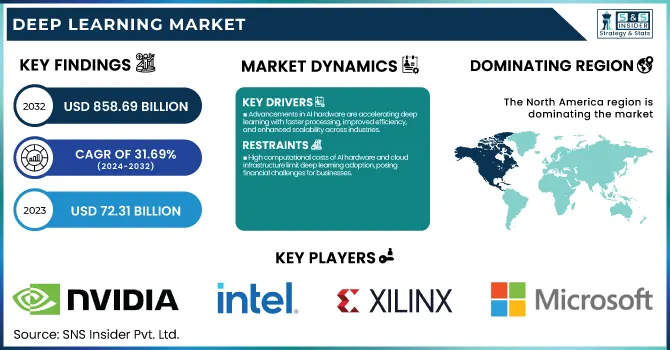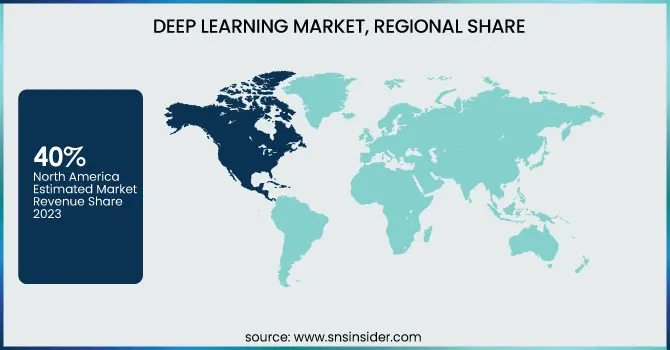Deep Learning Market Report Scope & Overview:
The Deep Learning Market was valued at USD 72.31 billion in 2023 and is expected to reach USD 858.69 billion by 2032, growing at a CAGR of 31.69% from 2024-2032. This report includes insights on adoption rates, investment trends, data volume trends, and model training expenses. The industry is growing at a fast pace, fueled by rising adoption across sectors like healthcare, finance, and automotive. Increased investments in AI infrastructure, coupled with growing datasets, are boosting model complexity. Rising training expenses are challenging this, which is further fueling developments in energy-efficient computing. While organizations pursue the use of deep learning to automate and make decisions, the need for cost-effective and scalable solutions is defining market trends, driving innovation and competition.

To Get more information on Deep Learning Market - Request Free Sample Report
Deep Learning Market Dynamics
Drivers
-
Advancements in AI hardware are accelerating deep learning with faster processing, improved efficiency, and enhanced scalability across industries.
Increased compute power from GPUs, TPUs, and neuromorphic chips is dramatically accelerating training and inference of deep learning models. Specialized processors bring more efficiency to the table, allowing for processing data faster and designing more complicated neural network topologies. Greater usage of specialty AI hardware lowers power consumption and enhances model precision, bringing deep learning into reach in more sectors. High-performance computing is also driving real-time AI innovation in applications such as autonomous systems, medical diagnostics, and natural language processing. As hardware advancements keep coming, deep learning models are increasingly becoming scalable, efficient, and powerful enough to deal with enormous data sets. All this technological acceleration is transforming industries, powering automation, and making new things possible with AI-based decision-making and predictive analytics.
Restraints
-
High computational costs of AI hardware and cloud infrastructure limit deep learning adoption, posing financial challenges for businesses.
Large amounts of memory and processing capability are required by deep learning training models, using expensive AI processors such as TPUs, GPUs, and optimized processors, requiring large operational investments. The prices of purchasing and keeping these enhanced computing systems bar small and mid-sized businesses, making it restrictive for mass-scale adoption. Also, cloud-based AI solutions, though scalable, are accompanied by recurring expenses that put pressure on budgets. The rising sophistication of deep learning models also increases resource needs, leading to increased energy consumption and infrastructure spending. As organizations try to achieve innovation while remaining cost-effective, the necessity for optimized AI hardware and affordable training methods becomes imperative. These financial issues need to be addressed to ensure increased accessibility and long-term sustainability of deep learning solutions.
Opportunities
-
Deep learning enhances hyper-personalization in e-commerce, entertainment, and customer engagement by delivering AI-driven tailored experiences in real time.
Deep learning is transforming personalization through the ability of AI systems to scrutinize large volumes of user data and provide customized experiences in real time. In online shopping, recommendation systems based on AI boost the shopping experience by accurately anticipating customer preferences. Deep learning is being used in the entertainment sector to develop customized content recommendations, maximizing viewer engagement. Companies are implementing AI-based chatbots and virtual assistants to offer personalized interactions, enhancing customer satisfaction and loyalty. With deep learning models evolving further, hyper-personalization is spreading to healthcare, finance, and education, providing personalized solutions according to personal requirements. This transition towards AI-based personalization is redefining customer engagement strategies, opening up new revenue streams, and building brand loyalty across industries.
Challenges
-
Inconsistent, biased, and insufficient data impact deep learning accuracy, limiting reliability and effectiveness across industries like healthcare and finance.
Deep learning models are dependent on large volumes of high-quality data for training, but inconsistencies, biases, and data unavailability can have a significant effect on their accuracy and effectiveness. Low-quality datasets may produce erroneous predictions, thus reducing the reliability of AI-based decision-making in mission-critical industries such as healthcare, finance, and autonomous vehicles. Biased training data can also yield unjust or incorrect results, posing ethical issues and regulatory problems. Furthermore, data fragmentation across industries prevents one from easily acquiring complete and representative datasets. Standardizing data, enhancing preprocessing methods, and applying bias-mitigation techniques are key to optimizing deep learning performance. Overcoming these data-related issues will be vital to unleashing the full potential of AI-powered innovations across sectors.
Deep Learning Market Segment Analysis
By Application
In 2023, the Image Recognition segment dominated the Deep Learning Market with the largest revenue share of approximately 43%. It is led by its extensive application across industries like security, healthcare, retail, and autonomous cars. Computer vision advancements, demand for facial recognition and object identification, and implementation in smart devices have propelled it. Moreover, the growth of AI-based surveillance systems and e-commerce platforms using image-based search and recommendation algorithms has been a major contributor to its market dominance.
The Data Mining segment is anticipated to expand at the fastest CAGR of approximately 34.98% during 2024-2032. This high growth is due to the rising amount of unstructured data in industries, which is fueling the need for deep learning algorithms to derive meaningful insights. Companies are utilizing data mining for predictive analysis, fraud detection, and customer behavior analysis. The growth of big data technologies, cloud computing, and AI-based decision-making processes further boosts its adoption, rendering it the fastest-growing segment in the Deep Learning Market.
By Solution
In 2023, the Software segment dominated the Deep Learning Market with the highest revenue share of about 48%. This dominance is driven by the increasing adoption of AI-powered applications across industries, including healthcare, finance, and automotive. Advancements in deep learning frameworks, neural network algorithms, and cloud-based AI solutions have further fueled demand. Businesses are investing in AI-driven analytics, automation, and natural language processing (NLP) tools, contributing to software’s strong market position. Additionally, the rise of AI-as-a-Service (AIaaS) has accelerated software adoption globally.
Hardware is anticipated to grow at the fastest CAGR of 33.63% during 2024-2032. It is energized by the surging demand for powerful computing infrastructure to service deep learning-driven applications. Growing usage of GPUs, TPUs, and AI accelerators in model training and inference fuels hardware innovation. Increasing investments in data centers, edge computing, and AI-based processors also amplify growth. The demand for effective, high-speed hardware solutions renders this segment the fastest-growing in the Deep Learning Market.
By End-use
The Automotive segment led the Deep Learning Market with the largest revenue share of approximately 25% in 2023. This is spurred by the increasing adoption of AI-driven technologies in autonomous vehicles, driver assistance systems, and predictive maintenance. Development of computer vision, sensor fusion, and real-time data processing have boosted the pace of AI penetration in automotive usage. Further investments in autonomous vehicle technology, smart transportation systems, and advanced safety features have added to the position of the automotive industry as the leader in the Deep Learning Market.
The Healthcare segment will expand at the fastest CAGR of 34.30% during the period 2024-2032. This high growth is driven by the increasing use of AI-based diagnostics, personalized medicine, and medical imaging solutions. Deep learning boosts disease detection, drug discovery, and patient monitoring, enhancing healthcare efficiency and accuracy. Increasing investments in AI-enabled healthcare solutions, telemedicine, and robotic surgeries also fuel adoption. The growing requirement for sophisticated data analytics and predictive modeling makes healthcare the fastest-growing segment in the Deep Learning Market.
Regional Analysis
North America led the Deep Learning Market with the largest revenue share of around 40% in 2023. The leadership is based on the extensive presence of prominent AI firms, high research and development activities, and high use of deep learning technologies in various industries. The area is favored with huge investments in AI infrastructure, cloud computing, and autonomous systems. Furthermore, growth in healthcare AI, smart manufacturing, and financial analytics, as well as government initiatives in favor of AI innovation, have further cemented North America's dominance in the Deep Learning Market.
Asia Pacific is expected to grow at the fastest CAGR of 33.73% from 2024 through 2032. Rising uptake of AI technologies in industries like manufacturing, healthcare, and e-commerce powers high growth in the region. Increasing investments in smart cities, automation, and research on AI drive market growth even further. The developing digital economy in the region, increasing number of AI startups, and government initiatives for artificial intelligence development are all factors that support Asia Pacific as the fastest-growing segment in the Deep Learning Market.

Get Customized Report as per Your Business Requirement - Enquiry Now
Key Players
-
NVIDIA (TensorRT, DGX Systems)
-
Intel (OpenVINO, Habana Gaudi)
-
Xilinx (Versal AI Core, Alveo U50)
-
Samsung Electronics (Exynos AI, HBM-PIM)
-
Micron Technology (Neural Cache, LPDDR5X)
-
Qualcomm (Snapdragon AI, Cloud AI 100)
-
IBM (Watson Studio, Power10 AI)
-
Google (TensorFlow, TPU)
-
Microsoft (Azure Machine Learning, Project Brainwave)
-
AWS (SageMaker, Inferentia)
-
Graphcore (IPU-Machine, Poplar SDK)
-
Mythic (M1076 AMP, Mythic Analog Compute Engine)
-
Adapteva (Epiphany AI Accelerator, Parallella)
-
Koniku (Konikore, Neuromorphic Chips)
-
ARM Ltd. (Ethos-N78, Cortex-A78AE)
-
Clarifai, Inc. (Clarifai API, AI Platform)
-
Entilic (DeepRadiology, Entilic AI Suite)
-
HyperVerge (HyperVerge Vision AI, Face Recognition API)
-
Advanced Micro Devices (Radeon Instinct, ROCm)
Recent Developments:
-
At CES 2025, NVIDIA CEO Jensen Huang unveiled the GeForce RTX 50 Series GPUs, powered by the new Blackwell AI chip, marking a significant advancement in AI-driven rendering for gamers, developers, and creators.
-
In 2025, Microsoft and OpenAI extended their partnership, securing exclusive rights to OpenAI’s models for Copilot and Azure OpenAI Service while maintaining revenue-sharing agreements. OpenAI also committed to expanding its use of Azure for model training and research.
| Report Attributes | Details |
|---|---|
| Market Size in 2023 | USD 72.31 Billion |
| Market Size by 2032 | USD 858.69 Billion |
| CAGR | CAGR of 31.69% From 2024 to 2032 |
| Base Year | 2023 |
| Forecast Period | 2024-2032 |
| Historical Data | 2020-2022 |
| Report Scope & Coverage | Market Size, Segments Analysis, Competitive Landscape, Regional Analysis, DROC & SWOT Analysis, Forecast Outlook |
| Key Segments | • By Solution (Hardware, Software, Services) • By Application (Image Recognition, Voice Recognition, Video Surveillance & Diagnostics, Data Mining) • By End-use (Automotive, Aerospace & Defense, Healthcare, Retail, Others) |
| Regional Analysis/Coverage | North America (US, Canada, Mexico), Europe (Eastern Europe [Poland, Romania, Hungary, Turkey, Rest of Eastern Europe] Western Europe] Germany, France, UK, Italy, Spain, Netherlands, Switzerland, Austria, Rest of Western Europe]), Asia Pacific (China, India, Japan, South Korea, Vietnam, Singapore, Australia, Rest of Asia Pacific), Middle East & Africa (Middle East [UAE, Egypt, Saudi Arabia, Qatar, Rest of Middle East], Africa [Nigeria, South Africa, Rest of Africa], Latin America (Brazil, Argentina, Colombia, Rest of Latin America) |
| Company Profiles | NVIDIA, Intel, Xilinx, Samsung Electronics, Micron Technology, Qualcomm, IBM, Google, Microsoft, AWS, Graphcore, Mythic, Adapteva, Koniku, ARM Ltd., Clarifai Inc., Entilic, HyperVerge, Advanced Micro Devices |

